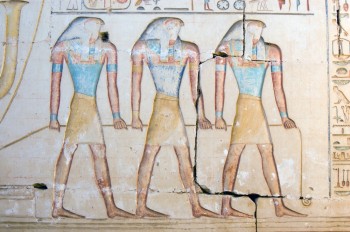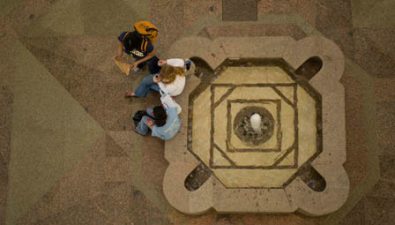 For ancient Egyptians blue was the color of rebirth. Today their chemical invention of artificial lapiz lazuli means new advances for lights, lasers and more.
For ancient Egyptians blue was the color of rebirth. Today their chemical invention of artificial lapiz lazuli means new advances for lights, lasers and more.
According to a new paper published in the Journal of the American Chemical Society the ancient pigment known as Egyptian blue may have important new applications in nanotechnology. Researchers at the University of Georgia in Athens, Georgia in the US were surprised to discover that Egyptian blue breaks into thin nanosheets, 1/1000th the width of a human hair which could be printed using ordinary ink-jet printer techniques. This along with other Egyptian blue properties may have important applications in medical science, telecommunication and lasers.
The earth tones of 15,000 year-old cave paintings were created with natural pigments of yellow and red ochre clay, soot, berries, animal parts and blood. Most of the world’s languages did not have a word for the color blue 5000 years ago when, sometime before Egypt’s fourth dynasty a clever alchemist heated copper, sand and natron. The resulting powder is composed of tiny crystals of calcium copper silicate (CaCuSi4O10.)
The Egyptian word for this substance was hsbd-iryt which means artificial lapiz lazuli. Before the discovery of Egyptian blue it was necessary to crush the valuable gemstone Lapiz Lazuli in order to reproduce the colors of rebirth, irtiu and khshdj.
Blue was the color of the heavens, the Phoenix, the primordial flood and the Nile. Egyptian blue spread quickly throughout the Greco-Roman world. The secret of its manufacture was lost during the fourth century A.D. and rediscovered more than 1400 years later by Sir Humphrey Davy of England.
 Its use declined when other pigments such as poisonous Prussian blue and carcinogenic cobalt blue became widely available, but its optical and nanotechnology properties has caused a renewed interest in this amazing and beautiful substance.
Its use declined when other pigments such as poisonous Prussian blue and carcinogenic cobalt blue became widely available, but its optical and nanotechnology properties has caused a renewed interest in this amazing and beautiful substance.
Egyptian blue emits a strong infrared light when exposed to visible light. Archaeologists use this fluorescence to reveal the presence of Egyptian blue in ancient art and also to reveal hidden detail. Tina Salguero, a chemist and materials scientist at the University of Georgia, in Athens, Ga was quoted by Inside Science News as saying, “Egyptian blue is composed of abundant and inexpensive elements — calcium, copper, silicon, and oxygen — in contrast to other near-infrared-emitting materials that contain rare earth elements.
This feature could provide economic and environmental benefits to future applications.” It is only speculation but one such application might involve energy efficient light emitting diode light sources. For example, most green solid state lasers begin with a strong infrared light source which passes through a frequency doubling crystal in order to change it to green light wavelengths.
Other possibilities include medical applications. Egyptian blue’s near infrared wavelength passes through human tissue more easily than visible light.
Egyptian blue’s discovery, loss and rediscovery are important reminders that sometimes we must study our past in order to discover our path to the future.
Images of blue Egyptian wallpaper and Egyptian wall painting from Shutterstock

![Amazing “Atlas” tracks Arab world habitat destruction over time [video] Amazing “Atlas” tracks Arab world habitat destruction over time [video]](https://www.greenprophet.com/wp-content/uploads/coastal-development-united-arab-emirates-370x198.png)

Thank you for the valuable Information.
Nadia Khairy
Cairo – Egypt
Thats cool!